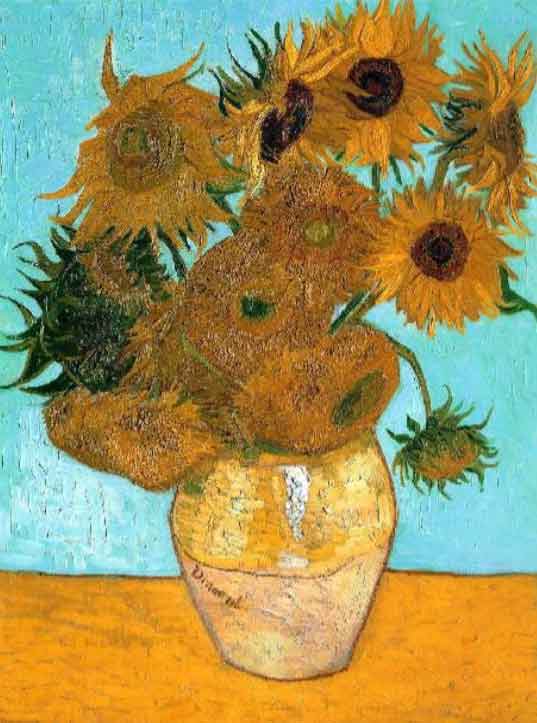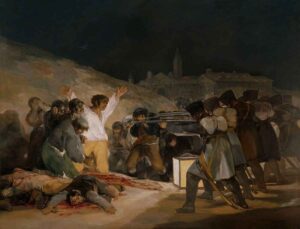Vincent Van Gogh's Still Life: Vase with Twelve Sunflowers
Vincent van Gogh (1853-1890), a Dutch Post-Impressionist, is one of the most well-known and influential figures in Western art history. In slightly over a decade, he made around 2,100 artworks, including approximately 860 oil paintings, the most of which were finished during his final two years in France. His paintings include landscapes, still lifes, portraits, and self-portraits, and are distinguished by strong colors and dramatic, spontaneous, and expressive brushwork that helped lay the groundwork for contemporary art. His suicide at the age of 37 came after years of mental illness and poverty.

Some of Vincent van Gogh’s most famous works are his Sunflower series. He painted a total of eleven of these canvases, although the most commonly referred to are the seven he painted while in Arles in 1888 – 1889. The other five he had painted previously while in Paris in 1887. Van Gogh planned to greet and impress his artist friend Gauguin by hanging a Sunflowers painting in the guest room of his Yellow House, where Gauguin stayed.
Van Gogh himself appears to have been completely fascinated with sunflowers, as seen by the overwhelming number of sunflower-based paintings he created as well as his description in letters to his brother and friends.

Van Gogh wrote this in 1888: “I’m painting with the gusto of a Marseillais eating bouillabaisse, which won’t surprise you when it’s a question of painting large sunflowers.” Everyone knew he had a thing for painting sunflowers. At the same letter, he would describe how it was his goal to work in a studio with his buddy Paul Gauguin, and how he planned to decorate the walls with giant sunflower paintings. Gauguin was most certainly an admirer of sunflowers, particularly those painted by Van Gogh. To Vincent’s dismay, Gauguin ‘claimed’ one of the sunflower paintings in exchange for some of his own work in 1889.
It’s time to look at some facts about Vincent van Gogh Sunflowers. Before we begin, let’s set the stage: Van Gogh was a Dutch artist who lived from 1853 till 1890. He died near Paris of a gunshot wound after several years of mental illness. During his lifetime he painted more than 2,000 paintings, drawings and watercolors which were used as reference by future painters, including Gauguin and Daumier.
Facts you should know about painting
- Van Gogh created 11 paintings in which sunflowers are the main topic and others in which they play a supporting role. During World War II, one was destroyed in a fire in Japan during an Allied bombing of Osaka.
- Van Gogh and Paul Gaugin traded paintings in Paris in 1887. Vincent's offering was a painting titled "Sunflowers" from his Paris series.
- The fact that blooms are strewn casually on a surface in groups of two or four distinguishes the artist's earlier Paris series from the Arles series, where they are arranged in greater abundance in a vase.
- The fact that blooms are strewn casually on a surface in groups of two or four distinguishes the artist's earlier Paris series from the Arles series, where they are arranged in greater abundance in a vase.
- When Van Gogh came to Arles, he began a creative period in which he incorporated yellow hues into his works. Several explanations have been proposed to explain this. One claim is that he drank too much absinthe, while another claims he drank too much digitalis. Yellow could have been colored by either material.
- The vivid yellow oil paints used in Van Gogh's "Sunflowers" were initially available in the early nineteenth century. He was one of the first to totally embrace them.
- Van Gogh was not alone in his fascination with sunflowers. Other well-known artists and poets that used the sunflower motif include William Blake in the late 1700s, Claude Monet in 1881, and Allen Ginsberg in 1955.
Conclusion
Van Gogh’s Sunflower series is a remarkable example of his creativity and aesthetic excellence. It also demonstrates how well he grasped the use of color and composition in conveying meaning and emotion via his paintings. All art enthusiasts are aware with Vincent van Gogh’s works and can appreciate how well he captured the essences of these sunflowers, making sure to capture their particular colors, shapes, and textures so that they would come alive within the frame of his paintings.


